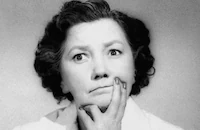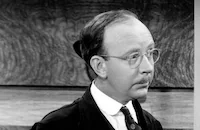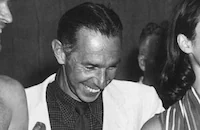Playmates

Brief Synopsis
Cast & Crew
David Butler
Kay Kyser
John Barrymore
Lupe Velez
Ginny Simms
May Robson
Film Details
Technical Specs

Synopsis
Lulu Monahan, press agent to actor John Barrymore, is trying to sell her client's services to Mr. Pennypacker, the sponsor of a local radio show. When Pennypacker rejects Barrymore because he is no longer in the public eye, Lulu devises a stunt to generate publicity for Barrymore. Teaming up with Peter Lindsey, press agent to band leader Kay Kyser, Lulu concocts a publicity stunt in which Barrymore will teach Shakespeare to Kay. Barrymore is reluctant to work with the "Dixieland MacBeth" until the Internal Revenue Service demands payment of his back taxes and Lulu assures him that the alliance will result in a lucrative radio contract with Pennypacker. When Lulu embellishes the stunt by promising a summer festival of Shakespearean plays starring Kay and Barrymore, Pennypacker's social-climbing wife is so impressed by the concept that she offers their Long Island estate for the festival. Barrymore then begins to tutor Kay, who recites Shakespeare with his Carolina twang. Although Barrymore fails to win the admiration of his pupil, he charms Kay's grandmother and Ginny, Kay's lead singer. When female bullfighter and former girl friend Carmen del Toro bursts upon the scene and demands Barrymore's attentions, the thespian devises a scheme to eliminate Kay by incinerating him with Carmen's fiery charms. Rather than exhausting Kay, however, Carmen's rumbas and congas energize him, thwarting Barrymore's plan. Four days before the performance, Kay is recording his speech when he leaves the room to speak to Grandma. The recorder is still running when Barrymore and Lulu enter the room and Barrymore relates a new scheme to eliminate Kay. When Kay replays the recording, he hears Barrymore's plans and decides to reciprocate. After arranging for Barrymore's guru, Prince Maharoohu, to summon the actor to meet the Grand Lama, Kay masquerades as the Grand Lama and tricks Barrymore into revealing his scheme to spray Kay's throat with an elixir that will render him speechless. When Ginny, who has accompanied Barrymore, insists on seeing the Grand Lama, Kay foretells two futures for her: one with an aging actor, the other with a nice young band leader. On the day of the festival, Kay pours the elixir into Barrymore's champagne glass and refills the atomizer with a harmless liquid. After drinking a toast to success, Barrymore takes command of the stage and is beginning to welcome the audience when he loses his ability to speak and is hooted off the stage. Kay and his band then take his place to present their swing version of Shakespeare, "Romeo Smith and Juliet Jones." Pennypacker is so impressed by the performance that he presents Barrymore with a radio contract, after which Ginny, taking the guru's advice, awards Kay with an embrace.

Director
David Butler
Cast

Kay Kyser

John Barrymore

Lupe Velez

Ginny Simms

May Robson

Patsy Kelly

Peter Lind Hayes
Kay Kyser's Band
Harry Babbitt
Ish Kabibble
Sully Mason
George Cleveland
Alice Fleming
Joe Bernard
Ray Cooke

Hobart Cavanaugh
Jacques Vanaire
Sally Cairns
Fred Trowbridge
Dorothy Babb
Leon Belasco
Grace Lenard
Sally Payne

Jack Arnold
William Halligan
Jack Carr
Bill Cartledge

George Mckay
Bill Chaney
Dave Willock
William Emile
Marshall Ruth
Wally Walker
Rube Schaffer
The Guardsmen
Crew
Johnny Burke
David Butler
Carroll Clark
Jack Crosby
Albert D'agostino
George Duning
Herbert Farjeon
Fred A. Fleck
James V. Kern
James V. Kern
Irene Morra
M. M. Musselman
Arthur Phillips
Frank Redman
Darrell Silvera
Edward Stevenson
Douglas Travers
James Van Heusen
Vernon L. Walker
Roy Webb
Earl A. Wolcott

Film Details
Technical Specs

Quotes
Trivia
Notes
According to a pre-production news item in Hollywood Reporter, Dennis O'Keefe was initially slated for a male romantic lead in this picture. In the CBCS, the character played by Peter Lind Hayes was originally named "Chuck Deems" and Lupe Velez's character was named "Conchita." Singer Ginny Simms made her last screen appearance with the Kay Kyser band in this picture before embarking upon her solo career as an actress. This was John Barrymore's last screen appearance; he died on May 29, 1942. The picture also marked the third Kay Kyser-David Butler collaboration produced by RKO.












